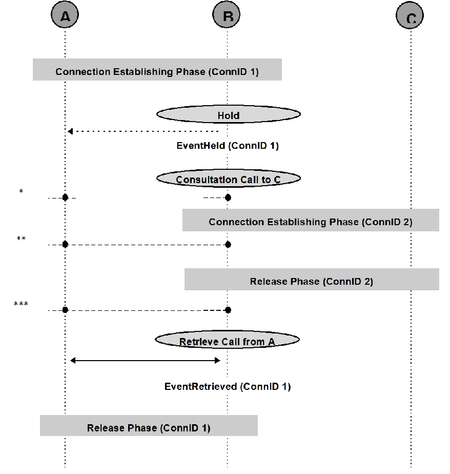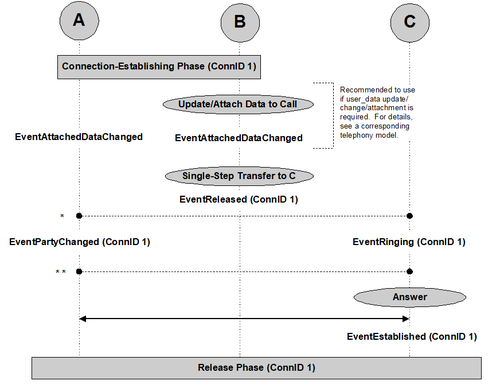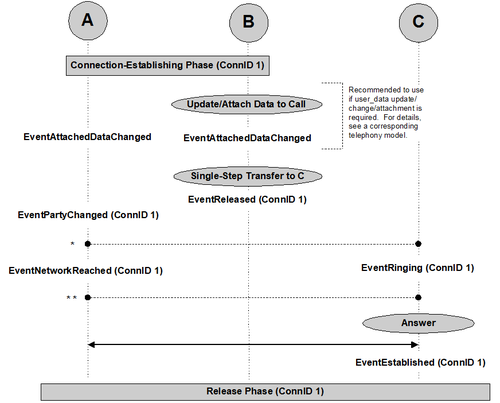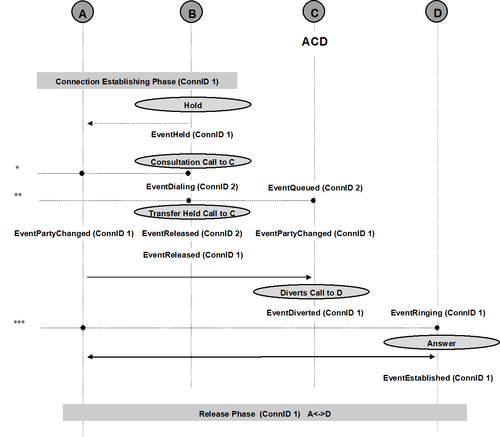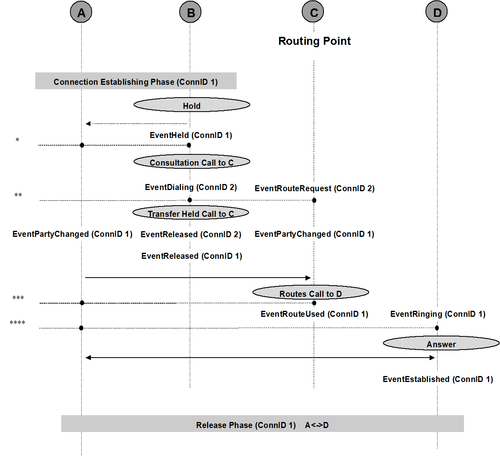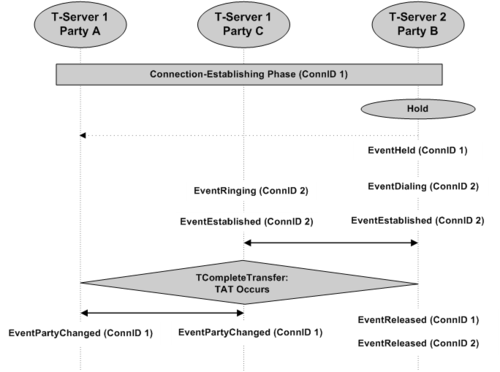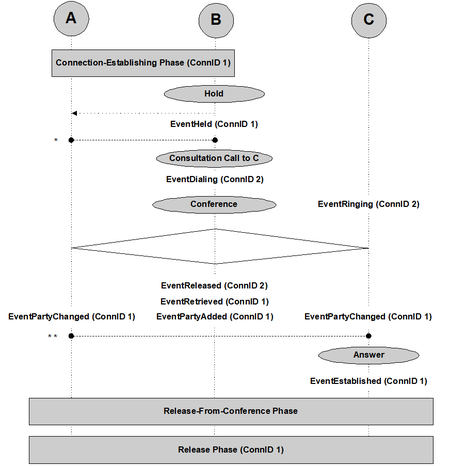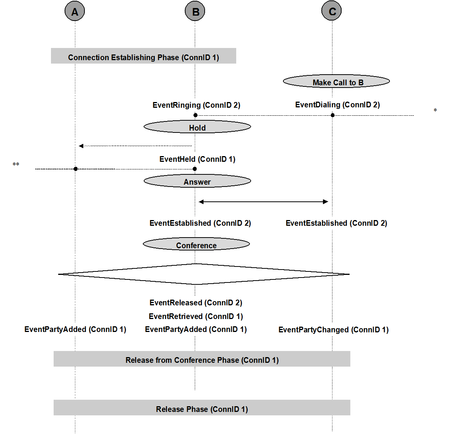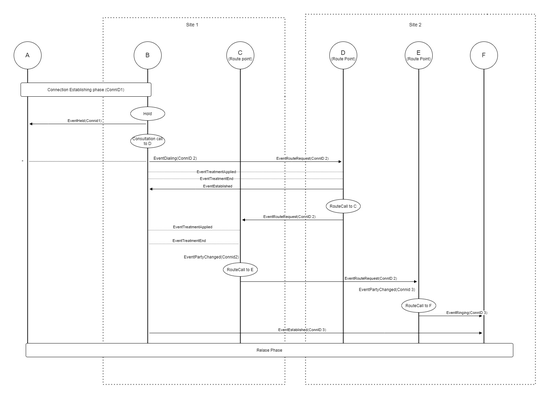Contents
- 1 Holding, Transferring, and Conferencing
- 1.1 Hold/Retrieve Function, Consulted Party Answers
- 1.2 Hold/Retrieve Function, Consulted Party Does Not Answer
- 1.3 Single-Step Transfer
- 1.4 Single-Step Transfer (Outbound)
- 1.5 Mute Transfer
- 1.6 Two-Step Transfer: Complete After Consulted Party Answers
- 1.7 Two-Step Transfer: Complete Before Consulted Party Answers (Blind)
- 1.8 Two-Step Transfer to ACD
- 1.9 Two-Step Transfer to a Routing Point
- 1.10 Trunk Optimization: Trunk Anti-Tromboning
- 1.11 Single-Step Conference
- 1.12 Conference
- 1.13 Blind Conference (Complete Before Consulted Party Answers)
- 1.14 Conference with Two Incoming Calls Using TMergeCalls
- 1.15 Special case: Multi-site ISCC Transfers and Conferences
Holding, Transferring, and Conferencing
The call models here show the functions and events related to placing calls on hold, transferring calls, and creating conference calls.
Note the following comments in the call models:
*OPT—Optional.
*DIAL—May be a dialed number or is not present if T-Server has no information about the other party.
Hold/Retrieve Function, Consulted Party Answers
The following graphic and table describe the hold/retrieve function, when the consulted party answers.
| PARTY A | PARTY B | PARTY C |
|---|---|---|
|
Call-Establishing Phase (ConnID 1) | ||
| Hold (THoldCall) | ||
| EventHeld ConnID 1 |
||
| Make Call to C (Consultation) (TMakeCall) | ||
|
Call-Establishing Phase (ConnID 2) | ||
|
Release Phase (ConnID 2) | ||
| Retrieve Call from A (TRetrieveCall) | ||
|
EventRetrieved a ConnID 1 |
|
|
Release Phase (ConnID 1) | ||
a. With EventRetrieved, the values for attributes ThisDNRole and ThisQueue are the same as those for the attributes of the same names, if any, in the events preceding EventRetrieved (EventEstablished and EvenRinging). For non-ACD calls, however, ThisQueue is not reported.
| Interruption Point | PARTY A | PARTY B |
|---|---|---|
| * | EventReleased ConnID 1 |
EventReleased ConnID 1 |
| ** | EventReleased ConnID 1 |
EventReleased ConnID 1 |
| *** | EventReleased ConnID 1 |
EventReleased ConnID 1 |
Hold/Retrieve Function, Consulted Party Does Not Answer
The following graphic and table describe the hold/retrieve function, when the consulted party does not answer.
| PARTY A | PARTY B | PARTY C |
|---|---|---|
|
Call-Establishing Phase (ConnID 1) | ||
| Hold (THoldCall) | ||
| EventHeld ConnID 1 |
||
|
Unsuccessful Internal Call (Party Does Not Answer) (ConnID 2) | ||
| Retrieve Call from A (TRetrieveCall) |
||
| EventRetrieved a ConnID 1 |
||
|
Release Phase (ConnID 1) | ||
a. With EventRetrieved, the values for attributes ThisDNRole and ThisQueue are the same as those for the attributes of the same names, if any, in the events preceding EventRetrieved (EventEstablished and EvenRinging). For non-ACD calls, however, ThisQueue is not reported.
| Interruption Point | PARTY A | PARTY B |
|---|---|---|
| * | EventReleased ConnID 1 |
EventReleased ConnID 1 |
| ** | EventReleased ConnID 1 |
EventReleased ConnID 1 |
Single-Step Transfer
The following graphic and table describe a single-step transfer.
| PARTY A | PARTY B | PARTY C |
|---|---|---|
|
Call-Establishing Phase (ConnID 1) | ||
| Single-Step Transfer to C (TSingleStepTransfer) | ||
|
EventReleased ConnID 1 |
|
| Answer (TAnswerCall) | ||
| EventEstablished ConnID 1 | ||
| Interruption Point | PARTY A | PARTY B | PARTY C |
|---|---|---|---|
| * | EventReleased ConnID 1 |
||
| ** | EventReleased ConnID 1 |
EventAbandoned ConnID 1 |
Single-Step Transfer (Outbound)
The following graphic and table describe a single-step transfer (outbound).
| PARTY A | PARTY B | PARTY C |
|---|---|---|
|
Call-Establishing Phase (ConnID 1) | ||
| Single-Step Transfer to C (TSingleStepTransfer) |
||
| EventPartyChanged ConnID 1 |
EventReleased ConnID 1 |
|
| Answer (TAnswerCall) | ||
| EventEstablished ConnID 1 | ||
| Interruption Point | PARTY A | PARTY B | PARTY C |
|---|---|---|---|
| * | EventReleased ConnID 1 |
||
| ** | EventReleased ConnID 1 |
EventAbandoned ConnID 1 |
Mute Transfer
The following graphic and table describe a mute transfer.
| PARTY A | PARTY B | PARTY C |
|---|---|---|
|
Call-Establishing Phase (ConnID 1) | ||
| Mute Transfer to C (TMuteTransfer*) | ||
| EventHeld ConnID 1 |
| |
| EventDialing ConnID 2 |
EventRinging ConnID 2 | |
| EventPartyChanged ConnID 1 |
EventReleased ConnID 1 |
EventPartyChanged ConnID 1 |
| Answer (TAnswerCall) | ||
| EventEstablished ConnID 1 | ||
|
Release Phase (ConnID 1) | ||
| Interruption Point | PARTY A | PARTY B | PARTY C |
|---|---|---|---|
| * | EventReleased ConnID 1 |
EventReleased ConnID 1 |
|
| ** | EventReleased ConnID 1 |
EventReleased
|
EventAbandoned ConnID 2 |
| *** | EventReleased ConnID 1 |
EventAbandoned ConnID 1 |
Two-Step Transfer: Complete After Consulted Party Answers
The following graphic and table describe a two-step transfer: complete after the consulted party answers.
| PARTY A | PARTY B | PARTY C |
|---|---|---|
|
Call-Establishing Phase (ConnID 1) | ||
| Hold (TInitiateTransfer*) | ||
| EventHeld ConnID 1 |
||
| Consultation Call to C (TInitiateTransfer continues) |
||
|
Call-Establishing Phase (ConnID 2) | ||
| Transfer Held Call to C (TCompleteTransfer) | ||
| EventPartyChanged ConnID 1 |
EventReleased ConnID 1 |
EventPartyChanged ConnID 1 |
|
Release Phase (ConnID 1) | ||
| Interruption Point | PARTY A | PARTY B | PARTY C |
|---|---|---|---|
| * | EventReleased ConnID 1 |
EventReleased ConnID 1 |
|
| ** | EventReleased ConnID 1 |
EventReleased ConnID 1 |
EventAbandoned ConnID 2 |
Two-Step Transfer: Complete Before Consulted Party Answers (Blind)
The following graphic and table describe a two-step transfer: complete before the consulted party answers (blind).
| PARTY A | PARTY B | PARTY C |
|---|---|---|
|
Call-Establishing Phase (ConnID 1) | ||
| Hold (TInitiateTransfer) | ||
| EventHeld ConnID 1 |
||
| Consultation Call to C (TInitiateTransfer continues) |
||
| EventDialing ConnID 2 |
EventRinging ConnID 2 | |
| Transfer Held Call to C (TCompleteTransfer) | ||
| EventPartyChanged ConnID 1 |
EventReleased ConnID 1 |
EventPartyChanged ConnID 1 |
| Answer (TAnswerCall) | ||
| EventEstablished ConnID 1 | ||
|
Release Phase (ConnID 1) | ||
| Interruption Point | PARTY A | PARTY B | PARTY C |
|---|---|---|---|
| * | EventReleased ConnID 1 |
EventReleased ConnID 1 |
|
| ** | EventReleased ConnID 1 |
EventReleased ConnID 1 |
EventAbandoned ConnID 2 |
| *** | EventReleased ConnID 1 |
EventAbandoned ConnID 1 |
Two-Step Transfer to ACD
The following graphic and table describe a two-step transfer to ACD.
| PARTY A | PARTY B | PARTY C (ACD) | PARTY D |
|---|---|---|---|
|
Call-Establishing Phase (ConnID 1) | |||
| Hold (TInitiateTransfer) | |||
| EventHeld ConnID 1 |
|||
| Consultation Call to C (TInitiateTransfer continues) |
|||
| EventDialing ConnID 2 |
EventQueued ConnID 2 |
||
| Transfer Held Call to C (TCompleteTransfer) | |||
| EventPartyChanged ConnID 1 |
EventReleased ConnID 2 |
EventPartyChanged ConnID 1 |
|
| Diverts Call to D | |||
| EventDiverted ConnID 1 |
EventRinging ConnID 1 | ||
| Answer (TAnswerCall) | |||
| EventEstablished ConnID 1 | |||
|
Release Phase (ConnID 1) | |||
| Interruption Point | PARTY A | PARTY B | PARTY C | PARTY D |
|---|---|---|---|---|
| * | EventReleased ConnID 1 |
EventReleased ConnID 1 |
||
| ** | EventReleased ConnID 1 |
EventReleased ConnID 1 |
EventAbandoned ConnID 2 |
|
| *** | EventReleased ConnID 1 |
EventAbandoned ConnID 1 |
Two-Step Transfer to a Routing Point
The following graphic and table describe a two-step transfer to a routing point.
| PARTY A | PARTY B | PARTY C (ACD) | PARTY D |
|---|---|---|---|
|
Call-Establishing Phase (ConnID 1) | |||
| Hold (TInitiateTransfer) | |||
| EventHeld ConnID 1 |
|||
| Consultation Call to C
(TInitiateTransfer continues) |
|||
| EventDialing ConnID 2 |
EventRouteRequest ConnID 2 |
||
| Transfer Held Call to C
(TCompleteTransfer) |
|||
| EventPartyChanged ConnID 1 |
EventReleased ConnID 2 |
EventPartyChanged ConnID 1 |
|
| Diverts Call to D | |||
| EventRouteUsed ConnID 1 |
EventRinging ConnID 1 | ||
| Answer (TAnswerCall) | |||
| EventEstablished ConnID 1 | |||
|
Call-Establishing Phase (ConnID 1) | |||
a. ThisDNRole must be Destination if party B is the call originator.
| Interruption Point | PARTY A | PARTY B | PARTY C | PARTY D |
|---|---|---|---|---|
| * | EventReleased ConnID 1 |
EventReleased ConnID 1 |
||
| ** | EventReleased ConnID 1 |
EventReleased ConnID 1 |
EventAbandoned ConnID 2 |
|
| *** | EventReleased ConnID 1 |
EventAbandoned ConnID 1 |
||
| **** | EventReleased ConnID 1 |
EventAbandoned ConnID 1 |
Trunk Optimization: Trunk Anti-Tromboning
Trunk optimization: trunk anti-tromboning (TAT) scenarios apply to functionality available from certain Nortel switches and are very similar to the case of Two-Step Transfer: Complete After Consulted Party Answers. The following graphic identifies the call model used by T-Servers to indicate a TAT event.
| T-Server 1 PARTY A |
T-Server 1 PARTY C |
T-Server 2 PARTY B |
|---|---|---|
|
Call-Establishing Phase (ConnID 1) | ||
| Hold (TInitiateTransfer to C) | ||
| EventHeld ConnID 1 | ||
| EventRinging ConnID 2 |
EventDialing ConnID 2 | |
| EventEstablished ConnID 2 |
EventEstablished ConnID 2 | |
| TCompleteTransfer | ||
| Trunk Optimization Occurs | ||
| EventPartyChanged ConnID 1 |
EventPartyChanged ConnID 1 |
EventReleased ConnID 1 |
Single-Step Conference
The following graphic and table describe a single-step conference.
| PARTY A | PARTY B | PARTY C |
|---|---|---|
|
Call-Establishing Phase (ConnID 1) | ||
| TSingleStepConference | ||
| EventPartyAdded ConnID 1 |
EventPartyAdded ConnID 1 |
EventRinging ConnID 1 |
| EventEstablished ConnID 1 | ||
|
Release from Conference Phase | ||
|
Release Phase (ConnID 1) | ||
a. ThirdPartyDN has a value of C if Party C initiates the request for a conference.
Conference
The following graphic and table describe a conference.
| PARTY A | PARTY B | PARTY C |
|---|---|---|
|
Call-Establishing Phase (ConnID 1) | ||
| Hold (See Application Activities for Different Types of Conference.) | ||
| EventHeld ConnID 1 |
||
| Consultation Call to C (See Application Activities for Different Types of Conference.) |
||
|
Call-Establishing Phase (ConnID 2) | ||
| Conference (See Application Activities for Different Types of Conference.) | ||
|
EventReleased ConnID 2 |
|
|
Release from Conference Phase | ||
|
Release Phase (ConnID 1) | ||
a. With EventRetrieved, the values for attributes ThisDNRole and ThisQueue are the same as those for the attributes of the same names, if any, in the events preceding EventRetrieved (EventEstablished and EvenRinging). For non-ACD calls, however, ThisQueue is not reported. b. If only one party is added (as in the case of a simple conference call), the corresponding telephony object is specified in OtherDN. If more than one party is added, then the corresponding telephony objects are specified in Extensions.
| Interruption Point | PARTY A | PARTY B |
|---|---|---|
| * | EventReleased ConnID 1 |
EventReleased ConnID 1 |
| Call Phase | Two-Step Conference | Conference with Calls Merge |
|---|---|---|
| HOLD | TInitiateConference | THoldCall |
| CONSULTATION CALL | TMakeCall | |
| CONFERENCE | TCompleteConference | TMergeCalls |
Blind Conference (Complete Before Consulted Party Answers)
The following graphic and table describe a blind conference (complete before the consulted party answers).
| PARTY A | PARTY B | PARTY C |
|---|---|---|
|
Call-Establishing Phase (ConnID 1) | ||
| Hold (See Application Activities for Different Types of Conference.) | ||
| EventHeld ConnID 1 |
||
| Consultation Call to C (See Application Activities for Different Types of Conference.) |
||
| EventDialing ConnID 2 |
EventRinging ConnID 2 | |
| Conference (See Application Activities for Different Types of Conference.) | ||
|
EventReleased ConnID 2 |
|
| Answer (TAnswerCall) | ||
| EventEstablished ConnID 1 | ||
|
Release from Conference Phase | ||
|
Release Phase (ConnID 1) | ||
a. With EventRetrieved, the values for attributes ThisDNRole and ThisQueue are the same as those for the attributes of the same names, if any, in the events preceding EventRetrieved (EventEstablished and EventRinging). For non-ACD calls, however, ThisQueue is not reported.
| Interruption Point | PARTY A | PARTY B | PARTY C |
|---|---|---|---|
| * | EventReleased ConnID 1 |
EventReleased ConnID 1 |
|
| ** | EventReleased ConnID 1 |
EventPartyDeleted ConnID 1 |
Conference with Two Incoming Calls Using TMergeCalls
The following graphic and table describe a conference with two incoming calls using TMergeCalls.
| PARTY A | PARTY B | PARTY C |
|---|---|---|
|
Call-Establishing Phase (ConnID 1) | ||
| Make Call to B (TMakeCall) | ||
| EventRinging ConnID 2 |
EventDialing ConnID 2 | |
| Place A on Hold (THoldCall) | ||
| EventHeld ConnID 1 |
||
| Answer (TAnswerCall) | ||
| EventEstablished ConnID 2 |
EventEstablished ConnID 2 | |
| Conference (TMergeCalls) | ||
|
EventReleased ConnID 2 |
|
|
Release from Conference Phase | ||
|
Release Phase (ConnID 1) | ||
a. With EventRetrieved, the values for attributes ThisDNRole and ThisQueue are the same as those for the attributes of the same names, if any, in the events preceding EventRetrieved (EventEstablished and EventRinging). For non-ACD calls, however, ThisQueue is not reported.
| Interruption Point | PARTY A | PARTY B | PARTY C |
|---|---|---|---|
| * |
|
EventAbandoned ConnID 2 |
EventReleased ConnID 2 |
| ** | EventReleased ConnID 1 |
EventReleased ConnID 1 |
Special case: Multi-site ISCC Transfers and Conferences
The following graphic and table describe a case involving multi-site ISCC transfers and conferences, in which EventPartyChanged may contain AttributeCallState set to 0.
| PARTY A | PARTY B | PARTY C | PARTY D | PARTY E | PARTY F |
|---|---|---|---|---|---|
Call Establishing Phase | |||||
| Hold (TInitiateTransfer) | |||||
|
EventHeld |
|||||
|
Consultation call to D |
|||||
|
EventDialing |
EventQueued |
||||
|
TreatmentApplied at D |
|||||
|
EventEstablished |
|||||
|
Call Routed to C |
|||||
|
EventQueued |
EventDiverted |
||||
|
TreatmentApplied at C |
|||||
|
EventPartyChanged |
|||||
|
Call Routed to E |
|||||
|
EventDiverted |
EventQueued |
||||
|
EventPartyChanged |
EventPartyChanged |
||||
|
Call Routed to F |
|||||
|
EventDiverted |
EventRinging | ||||
|
EventEstablished | |||||
Completion/Releasing phase | |||||
Abnormal Call Flow
|
Interruption Point |
PARTY B |
PARTY D |
PARTY C |
PARTY F |
| * |
EventReleased |
EventReleased |

